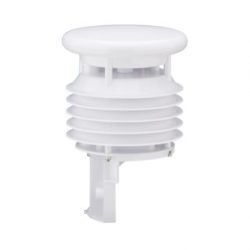Description
First Class Advanced Anemometer
This anemometer is an advanced first-class anemometer designed for the most rugged of applications, where accuracy is critical. Ideal for the renewable energy sector and meteorological observations for weather bureaus the this anemometer can come with or without an integrated heater.
It is designed and accredited according to EC61400-12-1 and ISO 17713-1 standards.
Specifications.
Output – RS-485 Modbus RTU.
|
Wind speed
|
|
|
Measuring range
|
0 … 75 m/s
|
|
Accuracy
|
< 1 % of meas. value (0.3 … 50 m/s)
or < ±0.2 m/s |
|
Linearity
|
r > 0.99999 ( 4 … 20 m/s )
|
|
Delay distance
|
< 3 m ( aac. to ASTM D 5096-96 )
|
|
Data output digital
|
|
|
Frequency
|
1082 Hz at 50 m/s
|
|
Operating voltage
|
|
|
Electronic
|
3.3 … 48 V DC
130 µA from 3,3 … 15 V 180 µA > 15 V |
|
Heating
|
without heating
|
|
General
|
|
|
Ambient temp.
|
-50 … +80 °C
|
|
Electr. connection
|
8 pol. plug connection
|
|
Mounting
|
onto mast tube Ø 1“
|
|
Protection
|
IP 55
|
|
Survival speed
|
80 m/s ( min. 30 minutes )
|
|
Weight
|
0.5 kg
|
|
Fixing boring
|
Ø 35 x 25 mm
|
|
Material housing
|
aluminium, anodised
|
|
Material cup star
|
carbon-fiber glass reinforced
|
What are wind speed sensors (anemometers)?
Anemometers are instruments and sensors which measure the speed of the wind. Modern anemometers usually use cups mounted on a spindle to ‘capture’ the wind, the speed at which the spindle rotates is directly related to the wind speed. Another form of anemometer utilises ultrasonic pulses to determine the wind speed and direction, these are considered a ‘solid-state’ instrument i.e. has no moving parts.
Anemometers are used in various industries for a multitude of applications such as weather bureaus to make weather forecasts, wind farms to monitor performance and to shut them off in very high winds, and transport organisations to help inform whether or not to close bridges or high roads in extremely windy conditions.





